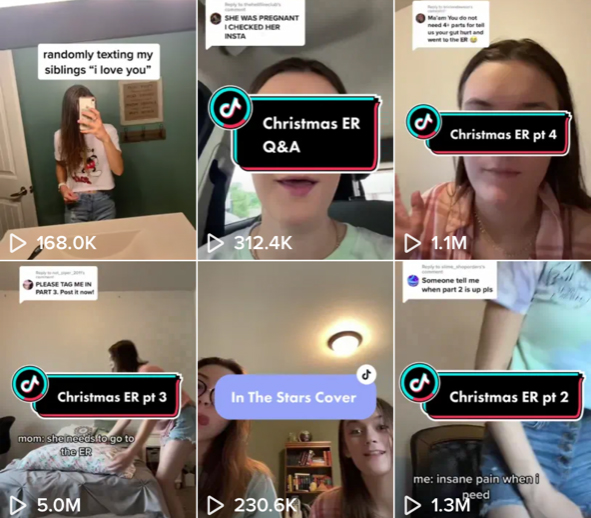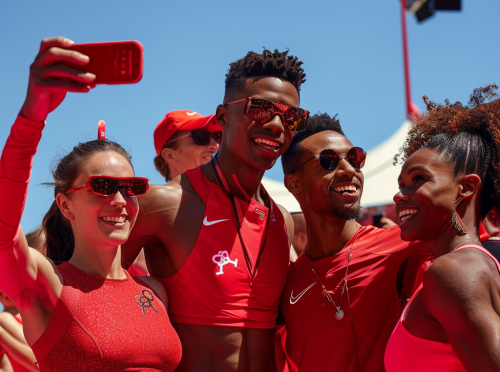Social is rewriting the playbook on sports engagement for the Olympics and beyond.
Content Wars: Long-Form Content isn’t Dead – it’s Being Disguised as Short-Form
Content preference trends are shifting as younger generations begin to dictate mainstream culture. As the ability to engage viewers becomes increasingly tricky in a crowded, multi-screen landscape, much of the best-performing content is bite-sized. In a recent survey conducted by HubSpot, more than half of marketers who reported using short-form video content in 2021 said they are continuing to increase investments in that direction throughout 2022. Many attribute the success of snackable content to research around potential changes in attentiveness across generations.
But are attention spans actually getting shorter? A recent trend on TikTok and Instagram Reels pokes a hole in this theory and suggests that social users do have the patience to watch longer content, depending on how it’s presented.
Episodic content for a new generation
A variety of popular accounts are posting long-form videos (like, entire television series long) broken down into shorter, multi-part videos that users can view continuously by visiting the account’s profile and scrolling through each post. Most content published in this format is centered around suspense genres, like true crime and medical TV shows that hook the viewer at specific, dramatic points throughout the story that keep viewers wanting more. People are still willing to engage with longer – even hours-long content – it may just require short-form packaging.

Coming off the popularity surge of YouTube over the last decade – a platform with traditionally longer-form content – the transition towards short videos has been a big change. And in today’s overly saturated digital world, it’s more crucial than ever to entice and hook viewers in the right way, and at the right time, to encourage continued viewing and interaction. But this may hold true regardless of how long a piece of content requires viewing.
Some doctors have emphasized the lack of evidence that there is such a thing as an average attention span at all, instead attributing attention to choice. The presence of this short-form episodic trend gleans insight into the motivations of digital media audiences and challenges the notion that the preference for longer-form storytelling is dead. The traditional style of long-form content may be, but the hunger for continuous storytelling in a compelling format is very much alive.
Rethinking storytelling can boost interaction
This style of longer content also has the potential to increase engagement in a big way. For the user to view each video within a multi-part series, they must click into the account that posted it where they’ll find the whole series. Thus, the result of suspenseful content stretching can be more views, likes, and follows. Many TikTok creators employ this tactic via “story time” videos that often stretch across multiple posts (the hashtag #StoryTime currently has 227.2B TikTok views.) Some users also include gaps in their posting schedule to further build suspense and increase the incentive for users to follow and return to their page later. This triggers social platform algorithms to continue feeding users who had previously engaged and already posted parts of the series more of the account’s videos – and there, the cycle continues.

An opportunity to experiment
Social users still have the patience to sit through longer stories, you just have to hook them. With the endless scroll of quick-bite videos that TikTok and Reels provide, capturing attention can require out-of-the-box thinking about not just the content itself, but the ways in which it is delivered to the eyes of viewers. Brands have the potential to EXPERIMENT, INCENTIVIZE, and GO BIG with creative content development.
EXPERIMENT
Test it out. With social trends shifting almost daily, brands have an opportunity to experiment with multi-part short-form episodic content in a variety of ways. There isn’t a clear rule book for this new phenomenon, and brands can put their own spin on the trend.
- A fashion brand could tell its heritage story by documenting a celebrity traveling to the country in which its products are produced. Showcase the unique aspects of the brand, its history, and its founders through episodes that offer untold, documentary-style brand stories. With each episode stretched out across multiple pieces of shorter content, but filmed over a single production shoot, this format is also a cost-saver. Use each “clip” as a test to see what’s getting the most hits, then amplify the most successful strategies through more ad spend.
INCENTIVIZE
Give them a reason to come back. Adopting a multi-part style of content can create awareness, engagement, and follow count by requiring users to visit your brand’s page to see the next video in the series.
- With the aim of increasing channel views, a snack brand could launch a new product through episodic content. Chronicle the journey of a personified/animated version of its mascot or spokesperson as they discover the new product line through an imaginary world. Save the product reveal for last, spacing out the posting of each video to entice users to check back for the end of the story and to learn about the new item(s).
GO BIG
Don’t shy away from increasing content output. Adopting this trend requires brands to create and post a lot more content than normal – and being fearless is key. Going big has the potential to pay off big with audience engagement.
- Start with a concept that has the potential for nearly unlimited content sourcing. To tap into cultural conversations, a music brand could be the first in the industry to create episodic docu-style videos showcasing its product use cases with popular musicians around the world. Highlight the creative process of music development with a long list of today’s most popular artists, with episodes beginning and ending during points of tension in the conversation.




